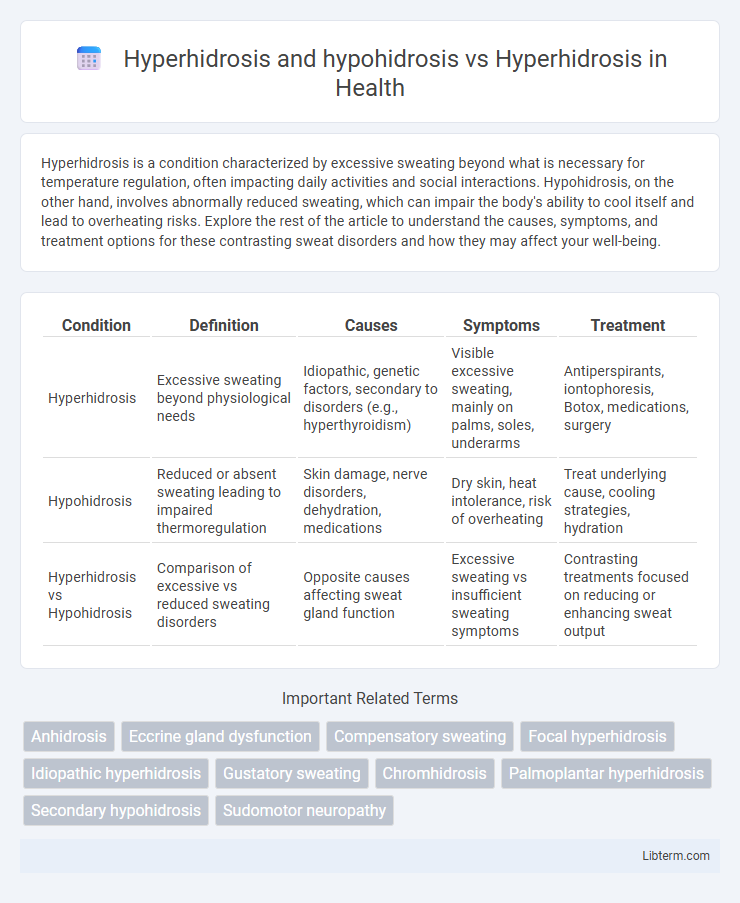Hyperhidrosis is a condition characterized by excessive sweating beyond what is necessary for temperature regulation, often impacting daily activities and social interactions. Hypohidrosis, on the other hand, involves abnormally reduced sweating, which can impair the body's ability to cool itself and lead to overheating risks. Explore the rest of the article to understand the causes, symptoms, and treatment options for these contrasting sweat disorders and how they may affect your well-being.
Table of Comparison
| Condition | Definition | Causes | Symptoms | Treatment |
|---|---|---|---|---|
| Hyperhidrosis | Excessive sweating beyond physiological needs | Idiopathic, genetic factors, secondary to disorders (e.g., hyperthyroidism) | Visible excessive sweating, mainly on palms, soles, underarms | Antiperspirants, iontophoresis, Botox, medications, surgery |
| Hypohidrosis | Reduced or absent sweating leading to impaired thermoregulation | Skin damage, nerve disorders, dehydration, medications | Dry skin, heat intolerance, risk of overheating | Treat underlying cause, cooling strategies, hydration |
| Hyperhidrosis vs Hypohidrosis | Comparison of excessive vs reduced sweating disorders | Opposite causes affecting sweat gland function | Excessive sweating vs insufficient sweating symptoms | Contrasting treatments focused on reducing or enhancing sweat output |
Understanding Hyperhidrosis: Definition and Symptoms
Hyperhidrosis is a medical condition characterized by excessive sweating beyond what is required for thermoregulation, often affecting the hands, feet, underarms, and face. In contrast, hypohidrosis involves abnormally low sweating, which can lead to overheating and heat-related illnesses due to impaired sweat production. Understanding hyperhidrosis involves recognizing symptoms such as persistent, uncontrollable sweat production that interferes with daily activities and may be primary (idiopathic) or secondary to underlying medical conditions.
Exploring Hypohidrosis: Causes and Manifestations
Hypohidrosis, characterized by reduced sweating, can result from skin disorders, nerve damage, or systemic conditions such as diabetes and Sjogren's syndrome. Unlike hyperhidrosis, which involves excessive sweating due to overactive sweat glands or nervous system dysfunction, hypohidrosis poses risks of overheating and heatstroke. Accurate diagnosis through sweat tests and neurological evaluations is essential to manage symptoms and address underlying causes effectively.
Key Differences Between Hyperhidrosis and Hypohidrosis
Hyperhidrosis involves excessive sweating due to overactive sweat glands, often triggered by heat, stress, or underlying medical conditions, whereas hypohidrosis is characterized by diminished or absent sweating, leading to impaired heat dissipation and potential overheating. Hyperhidrosis commonly affects areas like the palms, soles, and underarms, while hypohidrosis may result from skin disorders, nerve damage, or systemic diseases. Accurate diagnosis differentiates these conditions to guide treatment, as hyperhidrosis requires sweating reduction strategies and hypohidrosis demands measures to prevent heat-related complications.
Types of Hyperhidrosis: Focal vs Generalized
Hyperhidrosis is classified into two main types: focal and generalized, each with distinct characteristics. Focal hyperhidrosis primarily affects specific areas such as the palms, soles, underarms, or face, often triggered by emotional or thermal stimuli. Generalized hyperhidrosis involves excessive sweating across larger body regions and may be associated with underlying medical conditions, contrasting with hypohidrosis, which is characterized by abnormally reduced sweating and can lead to heat intolerance.
Underlying Medical Conditions Linked to Sweating Disorders
Hyperhidrosis is often linked to underlying medical conditions such as thyroid disorders, diabetes, and infections, causing excessive sweating, while hypohidrosis involves reduced sweating typically associated with skin conditions, nerve damage, or autonomic dysfunction. Both disorders reflect disruptions in the body's sweat regulation, with hyperhidrosis signaling an overactive sympathetic nervous system and hypohidrosis indicating impaired sweat gland function or neural pathways. Accurate diagnosis is critical for identifying systemic diseases like neuropathies or endocrine imbalances that contribute to these sweating abnormalities.
Diagnostic Approaches: Identifying Sweat Gland Dysfunction
Diagnostic approaches for hyperhidrosis and hypohidrosis focus on identifying sweat gland dysfunction through quantitative sudomotor axon reflex testing (QSART), thermoregulatory sweat tests, and iodine-starch sweat tests to measure sweat production levels. Hyperhidrosis diagnosis involves assessing excessive sweat secretion patterns, while hypohidrosis requires evaluating reduced or absent sweating linked to underlying neuropathies or skin disorders. Advanced imaging and biopsy may further help differentiate focal or generalized sweat gland abnormalities critical for targeted treatment strategies.
Treatment Options for Hyperhidrosis
Treatment options for hyperhidrosis include topical antiperspirants containing aluminum chloride, oral medications such as anticholinergics, and minimally invasive procedures like Botox injections that target overactive sweat glands. In severe cases, iontophoresis or surgical interventions like sympathectomy may be considered to significantly reduce excessive sweating. Hypohidrosis, characterized by reduced sweating, requires a different approach focusing on underlying causes rather than the treatments used for hyperhidrosis.
Management Strategies for Hypohidrosis
Management strategies for hypohidrosis focus on addressing the underlying causes, such as neuropathies, skin disorders, or medications, to restore normal sweating function. Use of topical agents like capsaicin or systemic treatments including pilocarpine can stimulate sweat production in affected areas. Patients are advised to maintain adequate hydration and avoid overheating to prevent heat-related complications associated with reduced sweating.
Psychological and Social Impact of Abnormal Sweating
Hyperhidrosis causes excessive sweating that significantly disrupts daily social interactions and psychological well-being by increasing anxiety, embarrassment, and self-consciousness. Hypohidrosis, characterized by insufficient sweating, can lead to overheating and social withdrawal due to discomfort and visible skin issues. Both conditions impair quality of life, but hyperhidrosis more directly triggers social stigma and emotional distress, necessitating targeted psychological support and therapeutic interventions.
Preventative Measures and Lifestyle Modifications
Preventative measures for hyperhidrosis primarily include avoiding known triggers such as spicy foods, caffeine, and stressful situations to reduce excessive sweating episodes. Lifestyle modifications like wearing breathable, moisture-wicking fabrics and maintaining good hygiene help manage symptoms effectively. In contrast, hypohidrosis requires careful skin hydration and avoiding overheating to prevent complications arising from reduced sweating capacity.
Hyperhidrosis and hypohidrosis Infographic

 libterm.com
libterm.com